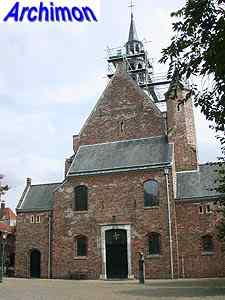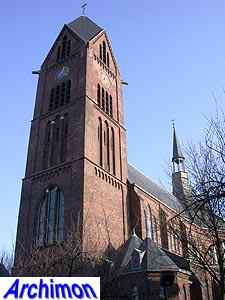
Venlo (L)
Venlo's history started in Roman times, when it was a centre of trade, the importance of which grew in the Carolingian period. In 1343 the place was chartered by the duke of Gelre, to which the town belonged for the next few centuries. In 1481 Venlo joined the Hanseatic League. In the 16th and 17th century the town was of strategic importance. In 1715 Venlo became part of the Republic permanently. Until 1867 the town remained a fortress. In the final months of World War Two the old centre was largely destroyed. Soon after the war reconstruction began.
De geschiedenis van Venlo begint in de Romeinse tijd, toen het een centrum van handel was waarvan het belang groeide in de Karolingische periode. In 1343 kreeg de plaats stadsrechten van de hertog van Gelre, waartoe de stad in de eeuwen daarna behoorde. In 1481 sloot Venlo zich aan bij de Hanze. In de 16de en 17de eeuw was de stad van strategisch belang. In 1715 werd Venlo permanent deel van de Republiek. Tot 1867 bleef de stad een vesting. In de laatste maanden van de Tweede Wereldoorlog werd het oude centrum grotendeels verwoest. Kort na de oorlog begon de wederopbouw.

Venlo's
major church is the St. Martinus, a three-aisled
hall-church from the 15th century. In 1945 the tower was destroyed and
after the war replaced by a new one, designed by Jules Kayser.
Location: Grote Kerkstraat 40
De belangrijkste kerk van Venlo is de St.Martinus, een driebeukige hallenkerk uit de 15e kerk. In 1945 werd de toren vernield en na de oorlog werd deze vervangen door een nieuwe, ontworpen door Jules Kayser.
Locatie: Grote Kerkstraat 40

The reformed church or Joriskerk consists of a medieval chapel which in 1713 was handed to the protestants and which was extended in 1718.
Location: St. Jorisstraat 16
De hervormde kerk of Joriskerk bestaat uit een middeleeuwse kapel die in 1713 aan de protestanten werd gegeven en die in 1718 werd uitgebreid.
Locatie: St. Jorisstraat 16

The Minderbroederskerk was built in 1617 as the church of the Franciscan monastery. The rest of the monastery was demolished after 1912.
Location: Minderbroedersstraat 2
De Minderbroederskerk werd gebouwd in 1617 als de kerk van het Franciscaner klooster. De rest van het klooster werd afgebroken na 1912.
Locatie: Minderbroedersstraat 2

The Augustinian
church dates from 1416 and belonged to the convent Mariaweide, of which
nothing else is left. The front part with stair-turret was added in 1955-1956 by,
once again, Jules Kayser.
Location: Nieuwstraat 41
De Augustijnenkerk dateert uit 1416 en behoorde tot het klooster Mariaweide waarvan verder niets over is. Het voorste gedeelte met de trap-toren werd in 1955-1956 toegevoegd door, wederom, Jules Kayser.
Locatie: Nieuwstraat 41

The Onze Lieve Vrouwekerk ('church of Our Lady'), architect P.J.H. Cuypers last church, dominates the southern part of Venlo since 1913. The tower was damaged in World War Two, and its upper part was rebuilt differently later.
Location: Sinselveldstraat 35
De Onze Lieve Vrouwekerk, de laatste kerk die architect P.J.H. Cuypers bouwde, domineert sinds 1913 het zuidelijk deel van Venlo. De toren werd beschadigd tijdens de Tweede Wereldoorlog en het bovenste gedeelte is later in gewijzigde vorm herbouwd.
Locatie: Sinselveldstraat 35

The Kerk van de Heilige Familie ('church of the Holy Family') dates from 1939 and was designed by architect A.J. Kropholler in conjunction with F.H. Stoks.
Location: Belletablestraat 21
De Kerk van de Heilige Familie dateert uit 1939 en werd ontworpen door architect A.J. Kropholler in samenwerking met F.H. Stoks.
Locatie: Belletablestraat 21